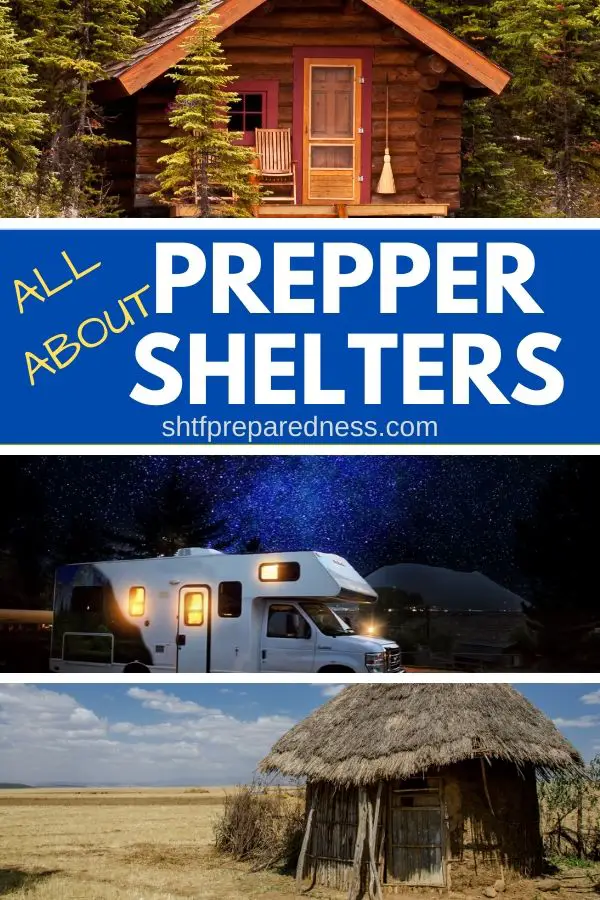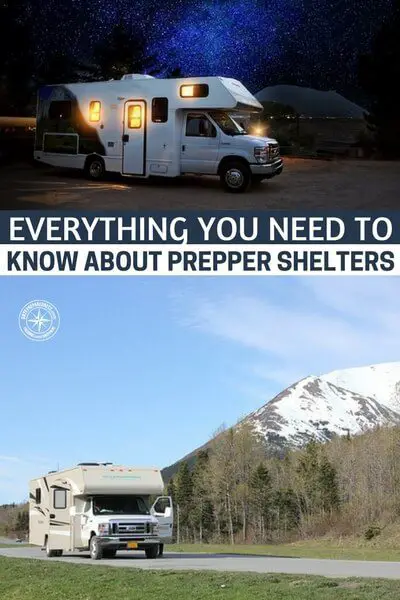If a catastrophe happened tomorrow, would you be prepared? I know you might have a bug out bag ready and maybe some food reserves, but do you have the proper shelter?
It’s one thing many don’t think about, but today we’ll look at all you need to know about prepper shelters. After reading and taking action on this, you’ll be ready!

Recently, I asked a friend if he thought he was prepared for a disaster scenario—something like a severe weather event or a human-caused catastrophe.
He said, “Sure, I am. I have a week or so worth of non-perishable food in the pantry and my AR-15 in case things get nasty.”
His response got me thinking about what it really means to be prepared for a situation in which there’s no support network to help you survive.
My friend was right about the non-perishable food. The weapon would come in hand too. But surely these things alone wouldn’t be enough to guarantee survival.
Just as the grocery store and police force aren’t the only things that keep me alive and comfortable, food and defense aren’t the sole instruments of preparedness for a disaster scenario.
I began to wonder about what my friend was missing. What would anyone who wants to be prepared for the worst need?
The answer that I arrived at is that all survival techniques rely on some kind of shelter—a home base for every other method of preparedness to come back to.
If your prepping efforts in other areas are up to snuff, but you’re not sure what kinds of prepper shelters are best for a disaster situation, here’s what you need to know.
The Keys to Good Emergency Shelter
What constitutes perfect shelter will vary depending on the circumstances. But here are a few things to think about when planning out your survival shelter.
Good Shelter Is Tough Enough to Stand up to a Disaster Scenario
How tough is tough enough is a judgment call that you have to make. It will depend on the sorts of disasters you’re liable to face.
A quick survival shelter in a temperate climate could easily withstand light rain and wind. But you’ll need something stronger if you’re worried about a global climate meltdown.
Twenty-seven million people are displaced each decade due to natural disasters. Those numbers are especially concentrated around less developed regions.
We can only expect things to be more serious in a disaster situation.
The Shelter Needs to Be Financially Feasible
A fortified bunker capable of withstanding a nuclear blast is probably on anyone’s wish list, but for most of us, it ain’t going to happen.
When you’re thinking about shelter for a survival situation, you need to be thinking to yourself: “Is it reasonable for me to acquire this before a disaster or in the midst of a survival situation?”
If you can’t, then it doesn’t matter how great that shelter could be. You can’t eat pie in the sky.
Prepper Shelters Should Be Independent
Finally, something that a lot of people don’t think about is whether or not the shelter they have in mind is totally independent.
To understand this, think about a modern house or apartment building. It’s probably got some strong walls and a well-built roof. It’s comfortable for long periods of time and is generally nice to live in.
However, in order to function at its peak, it needs to be connected to a functioning power grid, water supply, and gas line, among other things.
The point is that this structure is only good for survival when it’s well-supported. And unfortunately, you can’t count on that kind of support in a survival situation.
So that’s what you need to look for when picking out shelter for a survival situation. Now let’s take a look at some varieties of shelter. Let’s see how they stack up in terms of the qualities above.
Possible Prepper Shelters
Cabins

The log cabin shows how many of our ancestors survived without all the bells and whistles of modern society.
If a solar flare knocks out the electrical grid or an unrelenting virus decimates the human population, it could make a huge comeback.
A properly built cabin will withstand most weather events and hold up against regular wear and tear pretty well.
It can also be wonderfully independent, with old-style comforts, such as gas lamps and a wood furnace, and some newer survival tools, like roof-mounted solar panels.
The only major hurdle is accessibility. With enough research and time, almost anyone can build a cabin of their own. In fact, you can find a number of cheap cabin kits that will get you started with a good-quality off-grid cabin.
However, time is one thing that doesn’t exist in abundance in many survival scenarios. For this reason, it may be wise to start construction on a cabin or similar independent living structure before disaster strikes.
RVs

RVs, an overlooked form of shelter, carry several advantages. Perhaps most notable is their mobility.
A sufficiently prepared individual could possibly avoid a regional survival scenario altogether by simply getting out of the way before disaster strikes.
Well-constructed RVs can also be plenty durable as long as conditions don’t get too rough.
Where RVs get into trouble is independence. Since every RV requires gasoline to run, you’ll constantly be on the lookout for more in order to keep your shelter fully operational.
One thing you can do to get around this is learn to siphon gasoline from abandoned vehicles.
Emergency Shelter

Hardly anyone knows when and where a disaster will strike, making it hard to be 100 percent prepared at all times. One way to close this preparedness gap is to find ways to assembling an emergency shelter on the spot.
These sorts of prepper shelters include things like stick huts or tarp tents. These quick-and-dirty solutions are definitely accessible to someone with the right set of skills.
Unfortunately, they suffer when it comes to durability. Use these as a stepping stone to more reliable forms of shelter in a surprise disaster scenario.
The shelter is the foundation of all other survival techniques. Learn what kind of prepper shelters you need to prepare for whenever disaster strikes.

